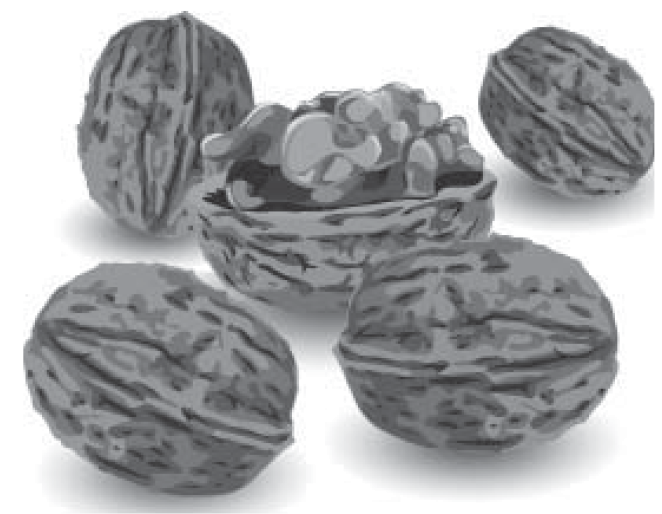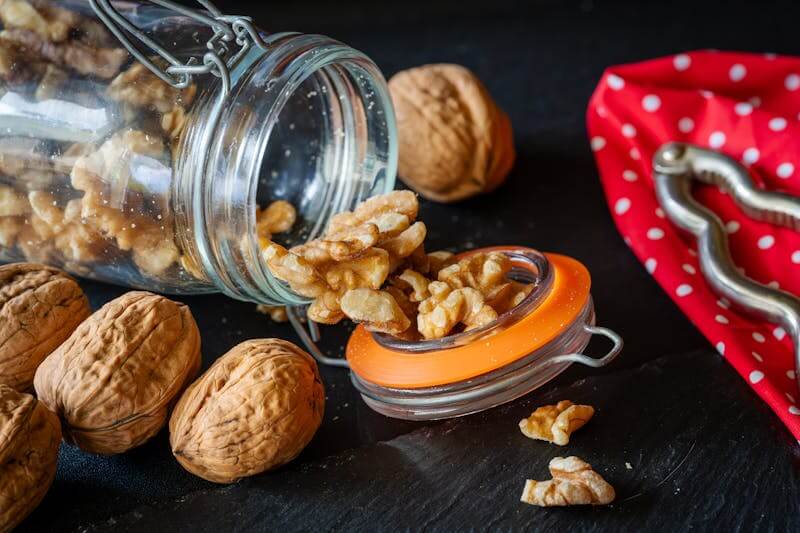Walnuts grow on trees and are typically harvested using mechanical shakers that shake the nut to the ground during harvest time in September through November. There are many walnut orchards in California due to its ideal climate for growing walnuts. Walnuts are harvested by machines which sweep the fallen walnuts into rows, and then the nuts are collected and taken to a processing plant where they are dried, sorted, and cleaned. Walnuts may be sold with their shells intact (“inshell”) or removed (“shelled”). Shelled walnuts are sold whole, in halves, or in pieces of various sizes.
Like a finely tuned engine, our bodies function best when we take good care of them. Choosing nutritious foods for our meals can help prevent certain diseases and obesity. A balanced diet should include protein, fat, carbohydrates, vitamins, minerals, and water.
Sources of protein include: fish, meat, poultry, dairy, eggs, nuts, and beans. Sources of carbohydrates include: fruits, vegetables, whole grains, and beans. Vitamins and minerals are found in most of these foods. For example, oranges are a good source of vitamin C, bananas are a good source of potassium, beef is a good source of iron, and milk is a good source of calcium.
A certain amount of fat is also an essential component of a healthy diet. Fat is the main energy storage molecule in the body. Our bodies require a certain amount of fat for cell growth, insulation from cold, energy production, and helps our body absorb vitamins A, D, E, and K until our body is ready to use them. Fat forms a protective layer around our internal organs and helps keep our skin and hair healthy.
Fat supplies calories and essential fatty acids to our diet. Sources of dietary fat are animal and dairy products, nuts, and oils. The Dietary Guidelines for Americans 2010 recommends that teenagers limit total fat intake to no more than 25 – 35% percent of total daily calories. For example, if a person eats 2,000 calories per day and 500 of those calories are from fat, this would fall in the 25 percent range. Fat has nine calories per gram. To find out how many grams of fat in 500 calories, divide 500 by nine to get 56 grams of fat.
There are different types of fat in food. Unsaturated (mono and poly unsaturated) fats are usually liquid at room temperature and are often referred to as oils. The Dietary Guidelines for Americans 2010 recommend getting the majority of necessary fat calories from unsaturated fat. Studies show that unsaturated fatty acid, when consumed in appropriate quantities, is associated with low blood cholesterol levels. This in turn leads to a lower risk of cardiovascular disease.
Saturated fat should be consumed in limited quantities but there is no dietary requirement for this kind of fat. Scientific research indicates there is evidence that the higher intake of most saturated fatty acids is associated with higher levels of blood total cholesterol and low density lipoprotein (LDL) cholesterol. This may be a risk factor for cardiovascular disease.
What Makes Walnuts Nutritionally Noteworthy?

- Walnuts are an excellent source of one type of unsaturated fat (polyunsaturated fat) Alpha-linolenic acid, an omega-3 fatty acid (2.5 grams/ounce). Research has shown that omega-3 fatty acids may help prevent coronary heart disease (CHD).
- One ounce of walnuts provides four grams of protein and two grams of fiber. Walnuts are also a good source of magnesium (10% DV) and phosphorus (10% DV) which are both important minerals involved in the body’s processes.
Nutrient dense walnuts are part of a healthy diet. They have a high level of essential Omega-3 fatty acids (2.5 grams/oz.). Omega-3 fatty acids have been shown to reduce the risk of coronary heart disease.
Walnuts make an easy snack because they can be eaten with no preparation at all. Many people enjoy eating walnuts raw and toasted. The shell of the walnut helps to keep the kernels fresh before eating. Walnuts add flavor and crunch to salads, main dishes, breakfast dishes, and even desserts.
When buying walnuts, it is important to properly store them if you are not going to eat them right away. Store walnuts in airtight containers in the refrigerator or freezer to maintain freshness. If stored in a warm place, the oil in walnuts can chemically change, causing them to spoil over time.

